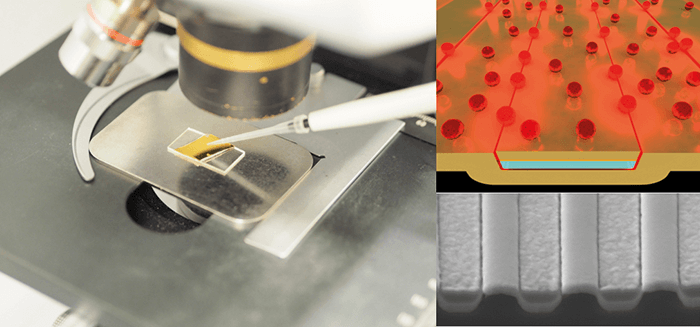The optical absorption spectra of trace chemical or biological molecules are typically very weak. Now, experts in material science, nano-optics and bio/chemical sensing have developed an optical device that is able to significantly enhance the absorption signal of trace molecules. The collaborative team’s light-trapping structure can squeeze infrared light into sub-5-nm gaps with very high efficiency, resulting in a very strong localized light field. They then demonstrated an application of this “squeezed” light using surface-enhanced infrared absorption (SEIRA) spectroscopy. The sensor, which acts as a substrate for the materials being examined, was found to boost the ability of SEIRA devices to detect molecules at 100 to 1,000 times greater sensitivity than previously reported results.

The device is officially called a “metamaterial super absorber”. But how does it work? “The unique sensor consists of two layers of metal with an insulator sandwiched in between,” says Qiaoqiang Gan, Associate Professor of Electrical Engineering, State University of New York at Buffalo, USA, and contributing author of the recent paper (1). “Using a fabrication technique called atomic layer deposition, we created a device with gaps less than 5 nm between two metal layers (a human hair is roughly 75,000 nanometers in diameter).” Creating such a small structure is a considerable challenge. “It is extremely difficult to produce uniform sub-5-nm features using current nanofabrication technologies,” explains Gan. “The major challenge is practical fabrication over large areas. Building upon atomic-layer-deposition processes, we developed a new scalable nanomanufacturing method, which we are currently using to develop large area structures.” The tiny gaps enable the sensor to absorb up to 81 percent of infrared light, a significant improvement from the 3 percent that similar devices absorb. And, Gan says, when the light is squeezed into such a small volume, its intensity is extremely strong, significantly enhancing its sensitivity in bio/chemical sensing applications, such as sports doping, forensics and art fraud detection. The ultra-sensitive bio-chip is still at the R&D stage, but the team are hoping to work on commercialization of the technology. “Our structure still relies on top-down nanomanufacturing methods like optical lithography,” says Gan. “If the manufacturing cost barrier can be addressed, we are aiming to deliver a new type of functional biochip for SEIRA as well as SERS sensing applications.”
References
- D Ji et al., “Efficient mid-infrared light confinement within sub-5-nm gaps for extreme field enhancement”, Adv Opt Mater, 5 (2017).



